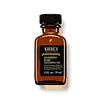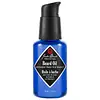What's inside
What's inside
 Key Ingredients
Key Ingredients

 Benefits
Benefits

 Concerns
Concerns

 Ingredients Side-by-side
Ingredients Side-by-side

Caprylic/Capric Triglyceride
MaskingPrunus Armeniaca Kernel Oil
MaskingPersea Gratissima Oil
Skin ConditioningSqualane
EmollientOlea Europaea Fruit Oil
MaskingPentaclethra Macroloba Seed Oil
EmollientTocopherol
AntioxidantCedrus Atlantica Bark Oil
MaskingSalicylic Acid
MaskingAmyris Balsamifera Bark Oil
MaskingGlycine Soja Oil
EmollientEucalyptus Globulus Leaf Oil
PerfumingMentha Piperita Oil
MaskingCitrus Aurantium Amara Leaf/Twig Oil
MaskingGeranium Maculatum Oil
MaskingLimonene
PerfumingIsopropyl Myristate
EmollientZingiber Officinale Root Oil
MaskingCitronellol
PerfumingLavandula Hybrida Oil
EmollientLinalool
PerfumingGeraniol
PerfumingFusanus Spicatus Wood Oil
MaskingCistus Ladaniferus Oil
EmollientFarnesol
PerfumingCitric Acid
BufferingCaprylic/Capric Triglyceride, Prunus Armeniaca Kernel Oil, Persea Gratissima Oil, Squalane, Olea Europaea Fruit Oil, Pentaclethra Macroloba Seed Oil, Tocopherol, Cedrus Atlantica Bark Oil, Salicylic Acid, Amyris Balsamifera Bark Oil, Glycine Soja Oil, Eucalyptus Globulus Leaf Oil, Mentha Piperita Oil, Citrus Aurantium Amara Leaf/Twig Oil, Geranium Maculatum Oil, Limonene, Isopropyl Myristate, Zingiber Officinale Root Oil, Citronellol, Lavandula Hybrida Oil, Linalool, Geraniol, Fusanus Spicatus Wood Oil, Cistus Ladaniferus Oil, Farnesol, Citric Acid
Cyclopentasiloxane
EmollientDimethiconol
EmollientHydrogenated Ethylhexyl Olivate
EmollientJojoba Esters
EmollientC12-15 Alkyl Benzoate
AntimicrobialVitis Vinifera Seed Oil
EmollientCaprylic/Capric Triglyceride
MaskingArgania Spinosa Kernel Oil
EmollientOlea Europaea Fruit Oil
MaskingSimmondsia Chinensis Seed Oil
EmollientHydrogenated Olive Oil Unsaponifiables
EmollientOryza Sativa Bran Oil
EmollientButyrospermum Parkii Butter
Skin ConditioningCitrullus Lanatus Seed Oil
EmollientTocopherol
AntioxidantDaucus Carota Sativa Root Extract
Skin ConditioningRosmarinus Officinalis Leaf Oil
MaskingMoringa Oleifera Seed Oil
EmollientSclerocarya Birrea Seed Oil
HumectantAdansonia Digitata Seed Oil
EmollientSchinziophyton Rautanenii Kernel Oil
EmollientHelianthus Annuus Seed Oil
EmollientGeranium Maculatum Oil
MaskingPrunus Insititia Seed Oil
EmollientAnthemis Nobilis Flower Oil
MaskingFucus Vesiculosus Extract
EmollientGlycine Soja Oil
EmollientBeta-Carotene
Skin ConditioningCyclopentasiloxane, Dimethiconol, Hydrogenated Ethylhexyl Olivate, Jojoba Esters, C12-15 Alkyl Benzoate, Vitis Vinifera Seed Oil, Caprylic/Capric Triglyceride, Argania Spinosa Kernel Oil, Olea Europaea Fruit Oil, Simmondsia Chinensis Seed Oil, Hydrogenated Olive Oil Unsaponifiables, Oryza Sativa Bran Oil, Butyrospermum Parkii Butter, Citrullus Lanatus Seed Oil, Tocopherol, Daucus Carota Sativa Root Extract, Rosmarinus Officinalis Leaf Oil, Moringa Oleifera Seed Oil, Sclerocarya Birrea Seed Oil, Adansonia Digitata Seed Oil, Schinziophyton Rautanenii Kernel Oil, Helianthus Annuus Seed Oil, Geranium Maculatum Oil, Prunus Insititia Seed Oil, Anthemis Nobilis Flower Oil, Fucus Vesiculosus Extract, Glycine Soja Oil, Beta-Carotene
Alternatives
Ingredients Explained
These ingredients are found in both products.
Ingredients higher up in an ingredient list are typically present in a larger amount.
This ingredient is an emollient, solvent, and texture enhancer. It is considered a skin-softener by helping the skin prevent moisture loss.
It helps thicken a product's formula and makes it easier to spread by dissolving clumping compounds.
Caprylic Triglyceride is made by combining glycerin with coconut oil, forming a clear liquid.
While there is an assumption Caprylic Triglyceride can clog pores due to it being derived from coconut oil, there is no research supporting this.
Learn more about Caprylic/Capric TriglycerideGeranium Maculatum Oil is an oil.
Glycine Soja Oil comes from the soybean. Glycine Soja is native to eastern Asia.
Soybean oil is an emollient. It is rich in antioxidants and fatty acids including palmitic, stearic, oleic, and linoleic acids.
As an emollient, the fatty acids in soybean oil helps keep your skin soft and hydrated. It does so by creating a film on top that traps moisture in.
Soybean oil is also rich in vitamin E, a potent antioxidant. Vitamin E is also anti-inflammatory and provides a soothing effect.
Studies show soy may help fade hyperpigmentation from UVB. It does so by disrupting the melanin process from UVB induced skin inflammation.
This ingredient may not be malassezia folliculitis, or fungal-acne, safe.
Soybeans are rich in proteins and are part of the legume family. Foods made with soybeans include tofu, soymilk, edamame, miso, and soy sauce.
Learn more about Glycine Soja OilOlea Europaea Fruit Oil is the fixed oil obtained from the ripe fruit of the Olive. In other words - olive oil.
The primary contents of olive oil are glycerides of the fatty acids linoleic, oleic and palmitic.
Olive oil also contains antioxidants such as Vitamin E. Antioxidants may help reduce signs of aging by fighting unstable free-radical molecules. It also contains Vitamins A (retinol), D, and K.
The squalene in olive oil makes it a great emollient. Emollients help soothe and soften your skin by trapping moisture in. This makes olive oil a great skin moisturizer.
Studies show olive oil to have antibacterial and antifungal properties in low concentrations. Another study found olive oil irritated sensitive oily skin. We always recommend speaking with a professional about using this ingredient in your routine.
Due to the fatty acid content, this ingredient may not be fungal-acne safe.
Learn more about Olea Europaea Fruit OilTocopherol (also known as Vitamin E) is a common antioxidant used to help protect the skin from free-radicals and strengthen the skin barrier. It's also fat soluble - this means our skin is great at absorbing it.
Vitamin E also helps keep your natural skin lipids healthy. Your lipid skin barrier naturally consists of lipids, ceramides, and fatty acids. Vitamin E offers extra protection for your skin’s lipid barrier, keeping your skin healthy and nourished.
Another benefit is a bit of UV protection. Vitamin E helps reduce the damage caused by UVB rays. (It should not replace your sunscreen). Combining it with Vitamin C can decrease sunburned cells and hyperpigmentation after UV exposure.
You might have noticed Vitamin E + C often paired together. This is because it is great at stabilizing Vitamin C. Using the two together helps increase the effectiveness of both ingredients.
There are often claims that Vitamin E can reduce/prevent scarring, but these claims haven't been confirmed by scientific research.
Learn more about Tocopherol